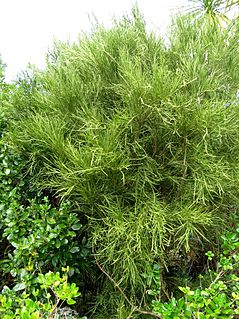
Carmichaelia is a genus of 24 plant species belonging to Fabaceae, the legume family. All but one species are native to New Zealand; the exception, Carmichaelia exsul, is native to Lord Howe Island and presumably dispersed there from New Zealand.

Carmichaelia glabrescens is a species of plant in the family Fabaceae. It is found only in New Zealand.
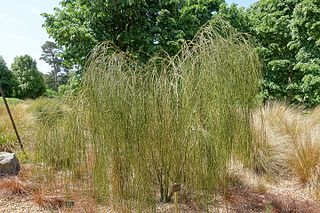
Carmichaelia stevensonii, the cord broom or weeping broom, is a species of plant in the family Fabaceae. It is found only in the north east of the South Island of New Zealand. It is threatened by habitat loss.

Carmichaelia muritai, common name coastal tree broom, is a species of plant in the family Fabaceae. It is found only in the South Island of New Zealand.
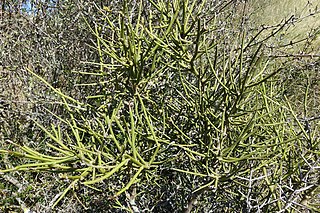
Carmichaelia petriei is a species of New Zealand broom belong to the genus Carmichaelia. It is endemic to New Zealand. C. petrieis is possibly a host plant for the critically endangered fungus weevil Cerius otagensis.
The Australasian Virtual Herbarium (AVH) is an online resource that allows access to plant specimen data held by various Australian and New Zealand herbaria. It is part of the Atlas of Living Australia (ALA), and was formed by the amalgamation of Australia's Virtual Herbarium and NZ Virtual Herbarium. As of 12 August 2014, more than five million specimens of the 8 million and upwards specimens available from participating institutions have been databased.

Opercularia vaginata (dogweed) is a species of plant within the genus Opercularia, in the family Rubiaceae. It is endemic to the southwest of Western Australia.

Kennedia lateritia, commonly known as Augusta kennedia, is a species of flowering plant in the family Fabaceae and is endemic to the south-west of Western Australia. It is a woody climber with twining stems, trifoliate leaves and orange-red and yellow flowers arranged in groups of up to twenty-four.

Myosotis eximia is a species of forget-me-not native to the North Island of New Zealand. The species was described by Donald Petrie.

Myosotis mooreana is a species of forget-me-not native to the southern South Island of New Zealand. The species was described by Carlos Lehnebach in 2012.

Carmichaelia astonii is a species of pea in the family Fabaceae. It is found only in South Island of New Zealand. Its conservation status (2018) is "Nationally vulnerable" under the New Zealand Threat Classification System.

Alternanthera nahui, common name nahui, is a species in the family Amaranthaceae, native to New Zealand and to Norfolk Island.

Carmichaelia appressa is a species of pea in the family Fabaceae. It is found only in the South Island of New Zealand. Its conservation status (2018) is "At Risk - Naturally Uncommon" under the New Zealand Threat Classification System.

Carmichaelia australis, or common broom, is a species of pea in the family Fabaceae. It is native to New Zealand and found in both the North and South Islands. Its conservation status (2018) is "Not Threatened" under the New Zealand Threat Classification System.
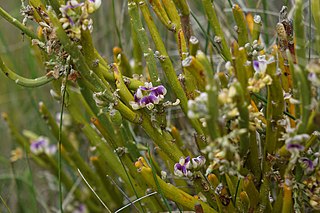
Carmichaelia hollowayi is a species of plant in the family Fabaceae. It is found only in the South Island of New Zealand. Its conservation status (2018) is "Nationally Critical" under the New Zealand Threat Classification System.
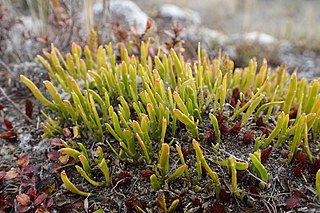
Carmichaelia nana is a species of plant in the family Fabaceae. It is found in both the North and South Islands of New Zealand. Its conservation status in 2013 was assessed as "At Risk (declinining)" under the New Zealand Threat Classification System, but in 2018 its risk under the same system became "Threatened-Nationally Vulnerable".
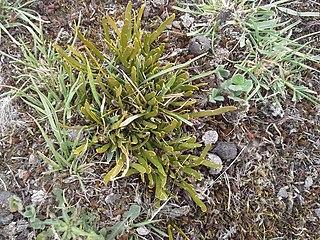
Carmichaelia corrugata is a species of plant in the family Fabaceae. It is found only on the South Island of New Zealand.

Acaena microphylla, the bidibid or piripiri, and outside New Zealand, New Zealand-bur, is a small herbaceous, prostrate perennial flowering plant in the rose family Rosaceae, native to both the North and South Islands of New Zealand. There are two varieties:

Isolepis aucklandica is a species of flowering plant in the Cyperaceae family. It is native to New Zealand, Australia, Argentina, Peru, Colombia, Ecuador, Macquarie Island, the French Southern Territories of Saint Paul and Amsterdam Islands, and New Guinea.

Juncus antarcticus, also known as dwarf rush, is a flowering plant species in the rush family Juncaceae, native to New Zealand and Australia.






















